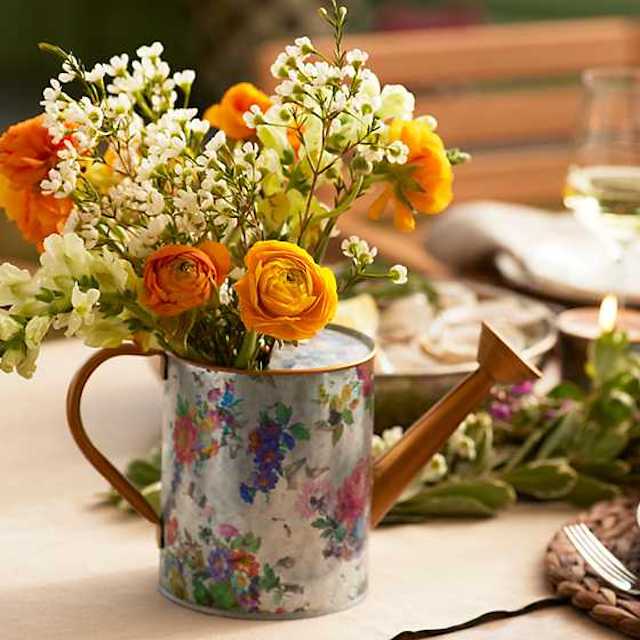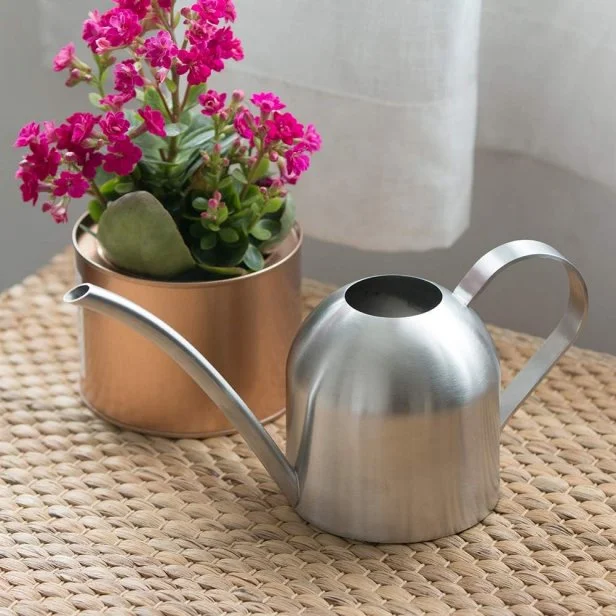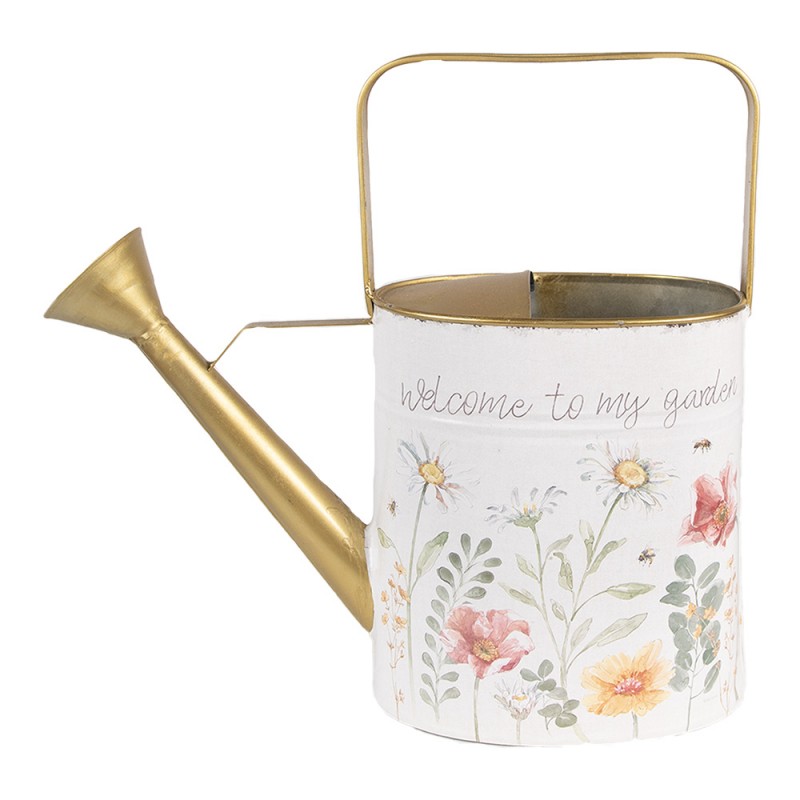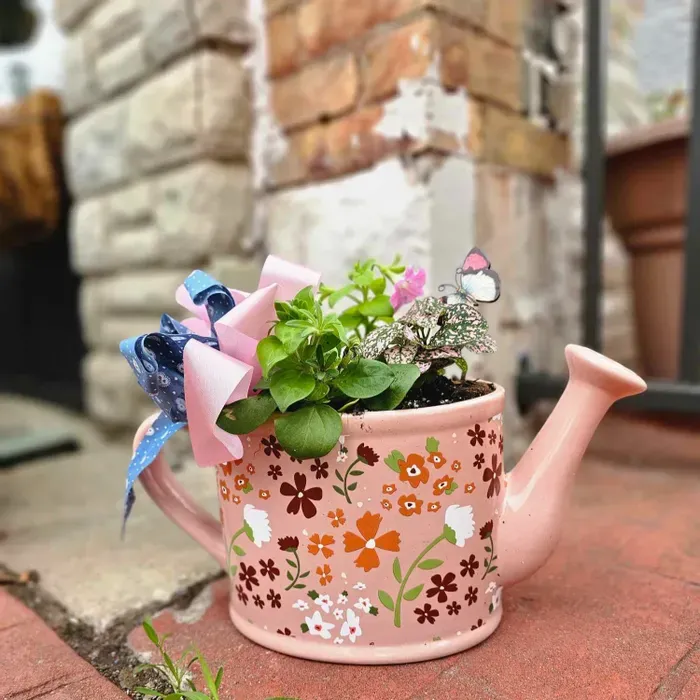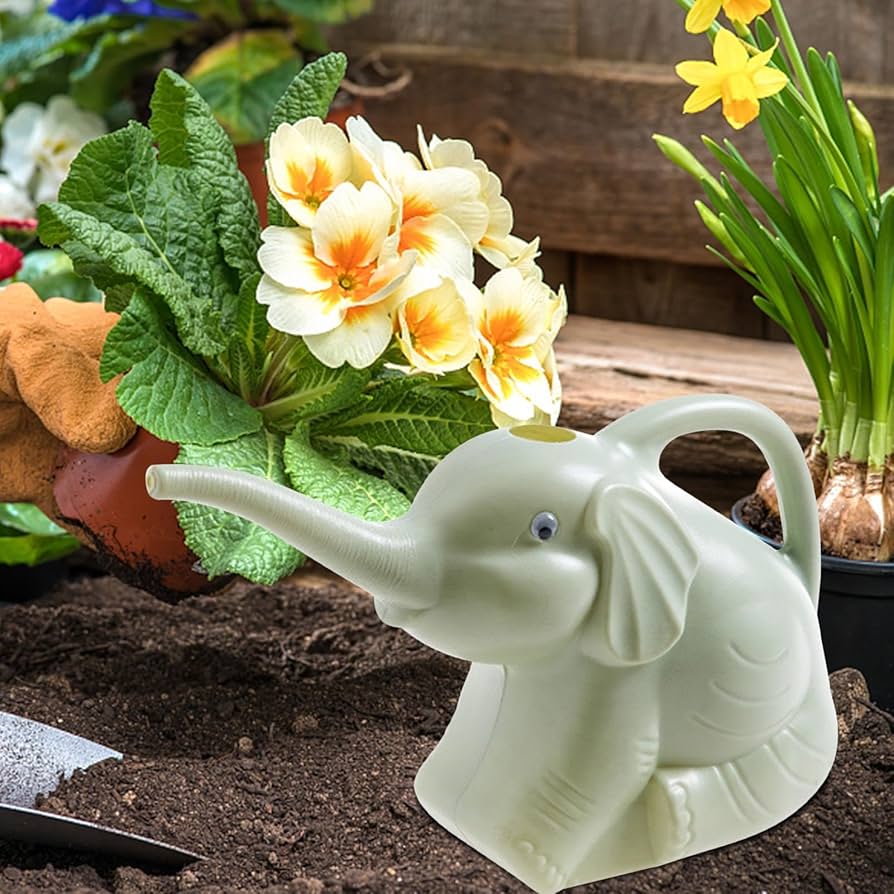
Decorative Watering Can Styles for Every Gardener’s Needs
The History of Watering Cans and Their Evolution
The watering can has a rich history, evolving through centuries. Originally, people used simple vessels like animal horns or sea shells to sprinkle water over plants. Over time, these tools transformed to meet gardener’s needs. By the 17th century, metal cans with a handle and spout became popular in Europe. These cans featured a rose—a removable nozzle that disperses water evenly, mimicking raindrops. This was a game-changer for seedlings and delicate flowers.
In the 19th century, the industrial revolution brought mass production. This made watering cans cheaper and more accessible to the average gardener. From there, designs exploded in variety. Materials switched up too. Metal remained a favorite, but plastic and ceramic options appeared. Each had its pros and cons, deciding factors for many garden lovers.
Today, the decorative watering can is both a tool and an art piece. Modern designs respect tradition but also break new ground. Some celebrate heritage with vintage looks. Others look forward, using innovative materials and styles. From basic functional models to those doubling as stunning garden decor, watering cans continue to blossom.
The evolution of watering cans reflects changing times and technologies. Yet, they remain a timeless staple in gardening culture. Whether serving as a practical item or a stylish statement, the watering can’s history showcases human ingenuity and our perennial love for gardening.
Comparing Materials: Metal vs. Plastic vs. Ceramic Watering Cans
Choosing the right material for a decorative watering can is crucial. It affects durability, weight, and style. Let’s compare metal, plastic, and ceramic options to find the best fit for your gardening needs.
Metal Watering Cans
Metal cans are tough and last long. They come in classic designs that often appeal to traditional gardeners. These cans can handle the elements, making them ideal for outdoor use. On the downside, metal cans can be heavy, especially when full. They may also rust over time if not cared for properly.
Plastic Watering Cans
Plastic cans are lightweight and cost-effective. They suit gardeners who prefer easy-to-carry and affordable options. Plastic doesn’t rust, which is a plus. However, it might not withstand harsh weather as well as metal. Also, some gardeners may find plastic less attractive for decorative purposes.
Ceramic Watering Cans
Ceramic cans are beautiful and often serve as decor pieces. They work well indoors and can come in various colors and designs. Ceramic is fragile though and can crack or break if dropped. These cans are generally more expensive and heavier than plastic, making them less practical for regular use.
Each material offers unique benefits and drawbacks. Consider where and how you’ll use your decorative watering can. Factor in the weight, weather resistance, and style that suits your garden best.
Elegant Design Options for Indoor Use
When selecting a decorative watering can for indoor use, elegance is often a top priority. Many gardeners seek cans that complement their interior decor while being functional. Here are some design options you’ll find appealing for indoor gardening:
Sleek Stainless Steel Designs
Stainless steel cans offer a modern look with a sleek finish. They are durable and resist corrosion, making them a smart choice for watering indoor plants. The reflective surface adds a touch of sophistication to any room.
Charming Ceramic Varieties
Ceramic watering cans come in a myriad of colors and patterns. These cans double as art, beautifying shelves or windowsills even when not in use. Their sturdy construction means they last, but remember, they can be heavy and delicate.
Compact Plastic Options
For tight spaces, compact plastic cans are ideal. They’re light and easy to store in small cabinets or shelves. While functional, plastic variants come in diverse styles, ensuring they don’t sacrifice looks for practicality.
Glass Watering Globes
Glass globes are a unique and elegant choice. They slowly release water to plants, combining functionality with a decorative appeal. Their subtle design suits any interior style, and they’re perfect for maintaining moisture levels while you’re away.
Brass Accents
Brass watering cans bring a vintage feel to your space. Their classic look, often with intricate details, can serve as a standout piece in your home. Plus, brass is resistant to corrosion, which is ideal for the humid environment of indoor gardening.
Your choice of an elegant decorative watering can for indoor use should align with both functionality and aesthetic. Keep in mind ease of use, weight, and overall style to find the perfect match for your home.
Functional and Stylish Watering Cans for Outdoor Gardens
When choosing a decorative watering can for outdoor gardens, function and style are key. These cans should endure outdoor conditions while boosting garden aesthetics. Here’s what to consider for an ideal outdoor option:
Durable and Weather-Resistant Materials
Look for materials that withstand sun, rain, and temperature changes. Metal cans, particularly those with a galvanized finish, resist rust and wear. Plastic varieties offer UV resistance and handle fluctuating weather well.
Large Capacities for Efficiency
Opt for larger capacities to reduce refill trips. This is efficient for watering multiple plants or larger gardens. However, consider the weight when full to ensure ease of use.
Ergonomic Designs for Comfort
Handle and spout design matter for comfort and control. Look for cans with a comfortable grip and a long, angled spout to reach plants easily.
Vibrant Colors and Patterns for Appeal
Select cans with colors or patterns that stand out. They can serve as a focal point in your garden setup. A pop of color adds life to your outdoor space.
Integrated Features for Convenience
Some cans include a sprinkler head or measuring lines. These features add convenience and precision to your watering routine.
Choosing a decorative watering can for outdoor use involves balancing practicality and style. Prioritize materials that last outdoors, comfort during use, and designs that complement your garden.
Hand-Painted and Artisan-Crafted Watering Cans
For those with an eye for unique artistry, hand-painted and artisan-crafted watering cans are treasures. They infuse personality and charm into your gardening essentials. Local artisans and crafters often use this as a canvas to showcase skill and creativity.
Locally Made, One-of-a-Kind Pieces
Hand-painted cans boast one-of-a-kind designs. Each carries the signature touch of its creator. These pieces reflect local culture and artistry. They are more than just tools; they tell a story and embody the love for craft.
Earth-Friendly and Sustainable Choices
Artisan watering cans often use sustainable methods and materials. They support the eco-conscious gardener. Choosing these cans means supporting local economies and reducing your carbon footprint.
Customization Options
Many crafters offer to customize your decorative watering can. You can request specific colors, patterns, or motifs. This service makes your watering can a personal statement piece. It also makes a thoughtful gift for fellow garden enthusiasts.
Durable and Functional Art
Don’t think these creations are only for display. Artisans design them for use too. They combine beauty with functionality. Expect durability and ergonomic features alongside the stunning visuals.
Hand-painted and artisan-crafted watering cans provide a delightful blend of art and utility. Consider one for a splash of elegance and tradition in your gardening routine.
Personalizing Your Watering Can: DIY Ideas
Adding a personal touch to your decorative watering can is fun and creative. It reflects your style and makes gardening even more enjoyable. Here are DIY ideas to personalize your watering can:
Custom Color Paint Jobs
Paint your can in colors that you love. Use spray paint for a smooth finish. Seal with a clear coat to protect against the weather.
Stenciled Designs
Apply stencils for neat patterns or shapes. Use acrylic paint and a sponge brush for best results. Remove the stencil while the paint is still wet for crisp lines.
Decoupage Art
Decoupage with fabric or paper cutouts adds character. Apply with decoupage glue and seal with a waterproof sealer. Choose themes that speak to your garden’s vibe.
Bejeweled Embellishments
Glue on gems or mosaics for sparkle and texture. Map out your design before you start. Use a strong adhesive designed for outdoor use.
Rope-wrapped Handles
Wrap the handle with jute or colored rope for a rustic look. Secure the ends with glue or clear tape. It gives a better grip and a bespoke feel.
Personalized Labels
Create labels with your plant names or inspiring quotes. Use waterproof markers or vinyl stickers. It’s both charming and functional, especially for garden novices.
DIY projects give a new life to your decorative watering can. They also make great gifts for friends who garden. Choose a DIY idea that excites you and have fun with the transformation.
Selecting the Right Size and Capacity for Your Needs
When looking for a decorative watering can, size and capacity are key. You need one that fits your garden’s scale. A large garden needs a can with more volume to save time on refills. For small indoor plants or herb gardens, a smaller can is enough.
Picking the Perfect Size
Choose a can that’s easy to lift and maneuver. For larger spaces, a can with a 2-gallon capacity works well. In tight indoor areas a 1-liter can should suffice. Remember, a full can gets heavy. It’s vital to find one that won’t strain your arms when watering.
Considering Watering Can Capacity
Think about the number of plants you have. More plants mean you’ll benefit from a larger capacity can. Be mindful not to choose one so big that it’s hard to pour from. A can that’s too big can also be awkward to store. Strike a balance between capacity and convenience.
Suitability for Plant Types
Determine the kind of plants you’re tending to. Delicate or small plants need gentle watering. A can with a small spout provides control and precision. For thirsty plants, a large spout can deliver more water quickly.
In summary, match the watering can’s size and capacity to your garden’s needs. Factor in space, number and type of plants, and how much water they need. With these considerations, you’ll find the perfect watering can that’s both useful and decorative.
The Best Places to Find and Purchase Decorative Watering Cans
When searching for the perfect decorative watering can, knowing where to look is key. Here are top places to find one:
Garden Centers and Nurseries
Local garden centers and nurseries often stock a variety of watering cans. You’ll find metal, plastic, and ceramic options suited for different uses. Staff can help you pick based on your garden’s needs.
Home Improvement Stores
Stores like Home Depot or Lowe’s offer watering cans that blend function with style. They have cans for every budget. Shopping in person lets you gauge the can’s feel and weight.
Online Marketplaces
Websites like Amazon and eBay feature a wide selection. From utilitarian to designer brands, it’s easy to compare prices and reviews. Plus, they deliver right to your doorstep.
Specialty Online Stores
Online stores specializing in gardening supplies curate selections for all styles. Sites like Gardener’s Supply Company provide quality cans that are also decorative. They often list materials and ergonomic details.
Antique Shops and Flea Markets
For vintage charm, check out antique shops and flea markets. You may find a unique, hand-painted piece. Prices can vary, so it’s worthwhile to explore and haggle.
Arts and Crafts Fairs
Local artisans display hand-crafted cans at these events. They’re perfect for unique and possibly customizable pieces. Supporting local artists feels good too.
Eco-Friendly and Artisan Retailers
Stores emphasizing sustainability and hand-made items stock eco-friendly cans. You’re likely to find something made with recycled materials.
In your hunt for the right decorative watering can, consider the array of choices. Weigh between brick-and-mortar stores or the convenience of online shopping. Always factor in your garden’s style and functional requirements when making your choice.
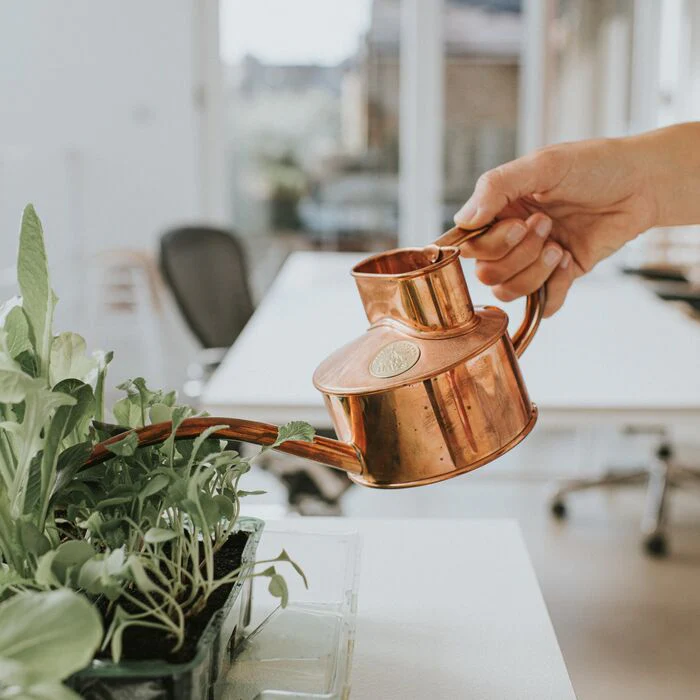
The Best Watering Can for Indoor Plants for Indoor Gardeners
Importance of Proper Watering for Indoor Plants
Proper watering is vital for indoor plants. It ensures they grow healthy and strong. Over-watering can lead to root rot, a common issue many indoor plant owners face. It kills roots, leaving plants unable to absorb nutrients. On the other hand, under-watering causes plants to wilt and can stunt growth. Soil needs the right balance of moisture. Without it, plants can’t perform photosynthesis well, affecting their overall health.
When choosing the best watering can for indoor plants, consider how its design helps with proper watering. A good can delivers water evenly. It avoids water logging and helps prevent dry spots. Consider cans with a long spout for reaching tight spaces. Such cans promote even watering at the plant’s base without wetting the leaves too much. Wet leaves can attract pests and diseases. Thus, proper watering tools are key to plant health and should be a top priority for indoor gardeners.
Factors to Consider When Selecting a Watering Can
When searching for the best watering can for indoor plants, several factors are key. Your choice impacts how well you can manage the watering needs of your plants. Here are important factors to consider:
Size and Capacity
Choose a size that fits your indoor garden. Large cans hold more water but could be too heavy when full. Small cans are lighter, easier to handle, but need more refills. Reflect on the number of plants and their water requirements before you decide.
Material and Durability
Watering cans come in different materials such as plastic, metal, or ceramic. Plastic is lightweight and often more affordable. Metal is more durable but can be heavy. Ceramic adds a decorative touch but can break easily. Pick a material that meets your balance of durability and ease of use.
Spout Design and Water Flow Control
A long spout can reach plants at the back of shelves or in tight spots. Look for a can with a detachable rose or adjustable nozzle. Such features allow you to control the water flow, reducing spillage and ensuring a gentle watering for delicate plants.
Comfort and Ergonomics
Comfort matters for regular use. Handles should offer a good grip and not strain your wrist. A balanced design prevents tipping when pouring. Opt for ergonomically designed cans for ease during longer watering sessions.
Aesthetics and Design
The look of the watering can may also be important. Pick a design that complements your interior decor. Many stylish options are available that serve both function and form. A good-looking watering can add charm to your plant care routine.
Top Watering Cans for Indoor Plant Care
Finding the best watering can for indoor plants depends on quality, functionality, and design. We have looked at several factors that play a role in choosing the right watering can. Now, let’s explore some of the top options that cater to the needs of your indoor garden.
Plastic Watering Cans
Plastic watering cans are a great lightweight option. They come in various sizes, making it easy to find one that suits your indoor space. Look for one with a detachable spout to control water flow, vital for delicate plants. Plus, they’re usually more cost-effective, offering a practical solution without compromising on functionality.
Metal Watering Cans
Metal watering cans boast durability and sturdiness. They stand out as long-term investments for your garden. Choose a can with a comfortable handle to ease the strain on your wrist. If you go for a metal option, ensure it has a coating to prevent rust, keeping your can functional for years to come.
Novelty and Decorative Watering Cans
For those who value aesthetics, novelty and decorative watering cans are perfect. They provide an extra touch of style to your gardening routine. While they are functional, these cans often serve as a decor piece as well. Remember to weigh their practicality with their appearance to select a can that best serves your plants’ needs as well as adds beauty to your space.
Tips for Watering Indoor Plants
Understanding Your Plants’ Water Needs
Each indoor plant has unique water needs. Learn what these are to water effectively. Some plants prefer dry soil between waterings, while others thrive in moist conditions. Check the soil with a finger-test or use a moisture meter. Knowledge of each plant’s preferences is key.
Techniques for Even Water Distribution
Ensure every plant gets the right amount of water. Use a watering can with a long spout for hard-to-reach areas. Water slowly to let the soil absorb moisture evenly. A detachable rose attachment helps disperse water gently, preventing soil disruption or mess.
Avoiding Overwatering and Underwatering
Overwatering and underwatering can harm your indoor plants. Use pots with drainage holes. Empty saucers after watering to avoid sitting water. Allow the topsoil to dry before watering again for most plants. Adjust your watering routine with the seasons, as indoor plants often need less water in winter.
Maintenance and Cleaning of Watering Cans
Proper maintenance is vital to extend the lifespan of a watering can. Whether it’s plastic, metal, or ceramic, consistent cleaning prevents algae growth and mineral deposit buildup. It keeps your tool in good condition and ensures that water flows freely, which is crucial for the well-being of your indoor plants. Here’s how to keep your watering cans clean and ready for use.
Routine Cleaning Tips
- Empty the can: Always empty residual water to prevent stagnant water that can harbor bacteria.
- Rinse with water: Regularly rinse the inside of the can with clean water to wash away leftover debris.
- Use mild soap: Occasionally, wash with a mild detergent to remove any slime or algae buildup.
- Scrub the spout: Use a bottle brush to clean the spout and remove clogs to ensure an even water flow.
- Air dry: Let the can completely air dry between uses to prevent moisture accumulation.
- Store properly: Keep your watering can in a dry place away from direct sunlight to avoid wear.
Preventing Rust and Corrosion on Metal Cans
Metal watering cans are durable but prone to rust if not cared for properly. To prevent rust and maintain their functionality:
- Dry immediately: After each use, thoroughly dry your metal can to prevent moisture from sitting.
- Oil the joints: Apply oil to moving parts like handles or roses to keep them functioning smoothly.
- Check for damage: Regularly inspect your can for scratches or chips in the paint that could expose metal.
- Use liners: Consider using a plastic liner if your metal can has begun to rust or corrode.
- Seasonal care: If you live in a humid area, you might need to give your can extra attention to avoid corrosion.
By following these maintenance and cleaning guidelines, the best watering can for indoor plants you’ve chosen will serve you well throughout your gardening endeavors.
Where to Buy the Best Watering Cans for Indoor Plants
Once you’ve decided on the best watering can for indoor plants, the next step is finding where to buy one. There are multiple options, and it’s all about convenience and variety.
Local Gardening Stores
Local gardening stores are a great place to start. Here, you can often find a selection of watering cans that you can physically examine. You’ll get a feel for their size and balance. Plus, the staff at these stores can provide personalized advice. They can help you choose a can that fits your specific indoor plant care needs. Local stores also support your community’s economy.
Online Retailers and Garden Centers
For a wider selection, online retailers and garden centers are your best bet. They offer a vast array of options, from the basic to the most stylish and decorative watering cans. Shopping online is convenient – you can compare prices and read customer reviews from the comfort of your home. Look for online stores with good return policies, in case the product doesn’t meet your expectations upon arrival.
When you shop, remember to balance your plant’s needs with the features of the can. Size, material, and spout design are all important features. Use the tips from this guide to make an informed choice for your indoor plants.
Final Thoughts on Making the Right Choice
When it comes to indoor plant care, a reliable watering can is a gardener’s best friend. Remember, the best watering can for indoor plants is one that meets both your and your plants’ needs effectively. Consider the size and volume that suit your space, the materials that align with your usage, and the design that matches your home aesthetic. The spout design should cater to the delicate watering needs of your plants, while ergonomic features ensure comfort during use.
Choosing wisely will not only simplify your plant care routine but also contribute to the overall health and growth of your indoor greenery. Keep in mind the tips and factors previously discussed, as they will guide you in selecting a can that’s easy to maintain and serves you for years. Whether in local stores or through online retailers, invest time in comparing options to find that perfect balance between functionality, durability, and style.
With proper maintenance and cleaning, your chosen watering can will be a lasting tool in your gardening arsenal. Let it reflect your commitment to nurturing your indoor plants, all while complementing your living space. Go forward with the knowledge shared here, and make a choice that you’ll be satisfied with each time you water your beloved plants.
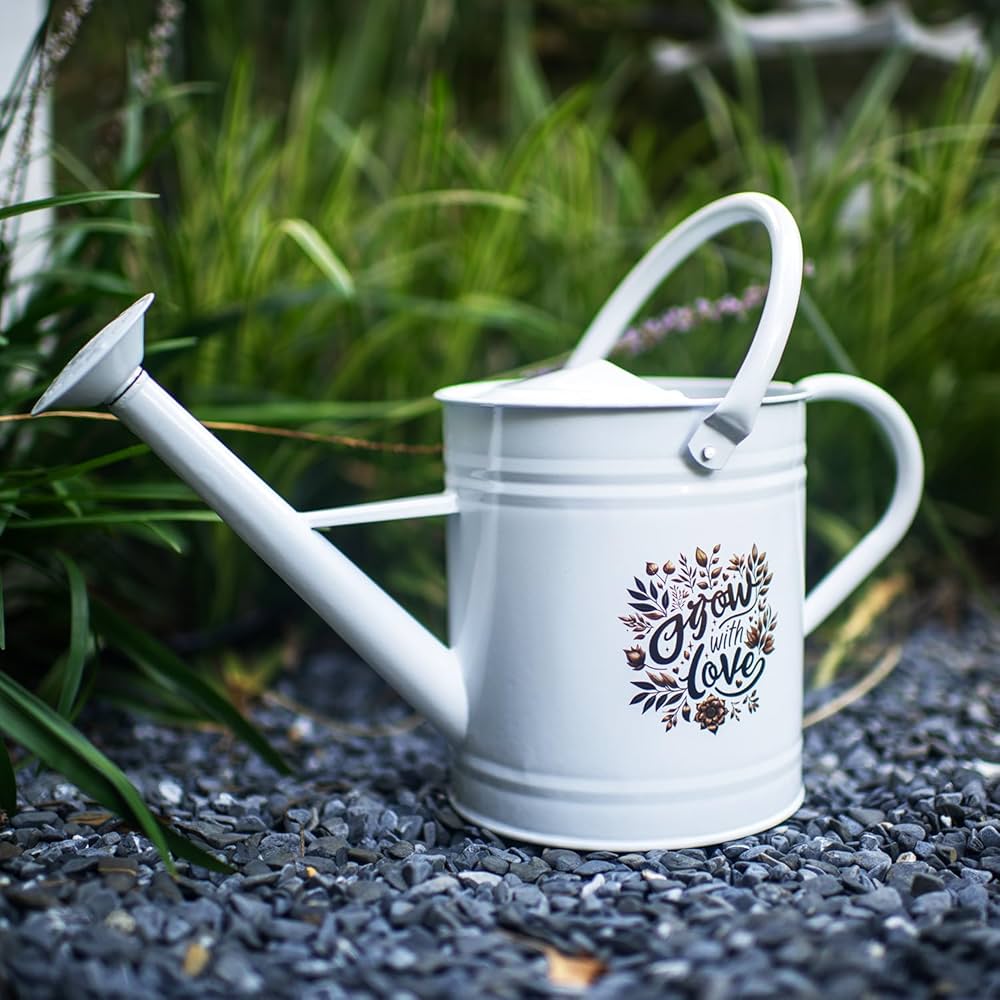
The Decorative Watering Can Designs for Indoor Plants
The Importance of Proper Watering for Indoor Plants
Ensuring your indoor plants receive the right amount of water is crucial for their health. Over-watering can lead to root rot, a common issue that hinders plant growth. Under-watering, on the other hand, can dry out the roots and weaken the plant. A decorative watering can not only add style to your plant care routine but also help you water effectively. It’s important to understand each plant’s unique watering needs. The right watering can design can offer precise control over the water flow. This control enables you to reach the soil directly without splashing and wetting the leaves, which can cause fungal infections.
An appropriate watering can with a long spout is ideal for targeted watering, reducing water wastage. Using a decorative watering can also serves as a visual reminder to care for your plants regularly. Keep in mind that the type of indoor plant you have can dictate the kind of watering can you might need. For example, succulents require less frequent watering than tropical plants, which may need a more consistent watering schedule. Balancing beauty with functionality, a decorative watering can be a perfect tool for maintaining the health and vitality of your indoor plants.
Classic Watering Can Designs and Their Appeal
Classic watering can designs have stood the test of time due to their functional elegance. These designs typically feature a balanced combination of a curved handle and a long spout. The iconic shape is not just for looks; it provides an ergonomic grip for ease of watering. Often made from materials such as galvanized steel or copper, these cans offer durability. The rustic aesthetic of a classic decorative watering can serves as a nod to traditional gardening.
In addition, the patina that develops on metal cans over time adds a touch of antiquity. It appeals to those who enjoy vintage or rustic home decor. Moreover, many plant enthusiasts believe traditional designs blend seamlessly into both indoor and outdoor settings. This timeless appeal makes the classic decorative watering can a popular choice for gardeners. Its simplicity does not clash with the natural beauty of the plants. Also, a classic can is often a go-to for those seeking a reliable and understated tool that gets the job done. Using such watering cans not only ensures efficient hydration for your plants but also adds a decorative element to your plant care routine.
Modern Watering Cans for a Contemporary Look
Modern watering cans offer more than just utility; they enhance the aesthetic of your indoor garden. These cans showcase sleek lines, bold colors, and innovative designs that fit well in contemporary spaces. Unlike classic styles, modern decorative watering cans often emphasize minimalism and functionality. Manufacturers use materials such as stainless steel, plastic, or recycled materials to capture a clean, sophisticated vibe.
Distinctive Shapes and Designs: The modern decorative watering can might come in unexpected shapes. Some are cylindrical, others might be rectangular. The handles and spouts might feature artistic curves or geometric angles. These designs can double as decor when they’re not in use.
Vibrant and Neutral Colors: Color is a significant aspect of modern cans. They are available in an array of colors, ranging from bright, eye-catching hues to understated, chic shades. It allows gardeners to match their watering can with their interior design palette or plant pots.
Combining Form and Function: High functionality is key in modern designs. They often come with detachable spouts for different watering pressures and ergonomic handles for comfortable grip. Designers integrate these features without compromising the watering can’s sleek silhouette.
Innovative Materials: The modern decorative watering can is also about materials. Designers often choose durable and lightweight alternatives over traditional metals. Some modern cans are made to be environment-friendly, suggesting a shift towards sustainability in gardening tools.
Multifunctional Accessories: Many modern cans include additional features such as measurement markings for precise watering, or in-built filters to prevent debris from clogging the spout. These accessories promote a more efficient watering routine.
In conclusion, when you choose a modern watering can, you’re selecting a tool that meets your watering needs while reflecting your style. The modern decorative watering can is a statement piece that stands out among classic options and provides an effortless blend of form and function.
Decorative Watering Cans as Functional Art Pieces
Choosing a decorative watering can that functions as an art piece is not just practical; it adds aesthetic value to your plant care. These watering cans become a focus in your indoor space, hinting at your personal style and love for gardening. When not in use, they can sit on a shelf or table, merging with your home’s decor as a standalone sculpture. Many owners feel proud to display these cans as part of their interior landscape.
Statement Designs: The unique designs of these decorative watering cans turn them into conversation starters. An artistic watering can might feature intricate patterns, bold graphics, or hand-painted details that showcase your personal taste.
Material Craftsmanship: Craftsmanship is central to these art pieces. The materials used, such as hand-blown glass or custom-forged metal, bring a high-quality and unique touch that mass-produced items cannot match.
Versatility in Use: Despite their artfulness, functional art watering cans are crafted to be fully functional. This ensures you can water plants with ease while enjoying the beauty of your can.
Reflecting Personal Aesthetics: Whether you favor a bohemian, minimalist, or avant-garde style, there’s a decorative watering can to suit your aesthetic. It’s the perfect way to infuse your personality into the daily ritual of plant maintenance.
By selecting a watering can that is both a functional tool and a piece of art, you create a more engaging and visually pleasing plant care experience. It’s about celebrating the beauty of the everyday and bringing joy to what might once have been considered a mundane task.
Eco-Friendly Watering Can Options
In the pursuit of sustainability, eco-friendly watering can options have emerged. These cans support green living and reduce environmental impact. Made from biodegradable materials or recycled products, they help gardeners maintain eco-conscious practices.
Biodegradable Materials: Some eco-friendly cans are crafted from natural materials that decompose over time. For instance, bamboo, which is fast-growing and sustainable, is a popular choice. It breaks down after its useful life, leaving minimal environmental footprint.
Recycled Plastics: Manufacturers are repurposing plastic waste to create watering cans. This approach keeps plastics out of landfills and oceans. Plus, it reduces the need for new plastic production.
Upcycled Designs: Creative minds turn old items into unique watering cans. Old bottles or containers get a second life as a decorative watering can. This not only saves resources but also adds a personal touch to your gardening tools.
Water Conservation Features: Some eco-friendly cans include features that promote water conservation. They might have nozzles that control water flow or systems that reuse household water.
Sustainable Production Processes: The creation of the can matters as well. Brands that use solar power or other renewable energy in production are making strides. They offer products with a lower carbon footprint.
By choosing an eco-friendly decorative watering can, you contribute to a healthier planet. You also support the industry moving towards sustainable practices. Next time you’re shopping, consider options that are kind to the earth and stylish for your home.
Watering Can Materials: Pros and Cons
When selecting a decorative watering can, the material is a crucial factor to consider. Here’s a quick look at the pros and cons of various materials commonly used:
Metal Watering Cans:
Pros: Metal cans are sturdy and long-lasting. They can withstand frequent use. Their weight gives them a stable base when full, reducing the risk of tipping over. Over time, metals like copper develop a unique patina adding to their charm.
Cons: They can be heavy, especially when filled with water, making them less ideal for those with limited strength. Metal cans may rust if not properly cared for. They are also usually more expensive than plastic options.
Plastic Watering Cans:
Pros: Plastic is lightweight, making it easy to carry, even for those with less hand strength. It’s often more affordable and comes in a variety of colors.
Cons: Plastic can degrade over time, especially when exposed to sunlight, leading to cracks and leaks. Some may not like the feel of plastic or its appearance compared to metal or ceramic cans.
Ceramic Watering Cans:
Pros: Ceramic offers a classic look and can be glazed in many decorative finishes. They often have intricate designs and can serve as a decor piece.
Cons: They are fragile and can crack or break if dropped. Ceramic cans are also heavier and typically more expensive due to their craftsmanship.
Stainless Steel Watering Cans:
Pros: Stainless steel is rust-resistant and durable. It has a sleek, modern appearance and is often used in contemporary designs.
Cons: These can show water spots and fingerprints, requiring more maintenance. Like other metal cans, they can be heavier and pricier.
When choosing your decorative watering can, weigh the pros and cons of each material against your needs and style preferences. Consider durability, weight, cost, and aesthetics to find the perfect fit for your indoor plant care.
Tips for Choosing the Right Watering Can for Your Plants
Selecting the correct decorative watering can for your indoor plants involves more than just style. Here are some tips to help you make the best choice for the health of your plants and the aesthetics of your home.
Consider Plant Needs: Each plant has distinct watering requirements. Ensure the can’s size and spout design fit the needs of your plant species.
Evaluate Space: Look at your indoor space. Choose a size that is easy to handle and store in your home.
Check the Spout: Long spouts reach the base of plants with ease, preventing leaf wetness. A detachable spout can offer versatility.
Test Ergonomics: Pick it up, if possible. It should feel comfortable in your hand, even when full.
Think About Durability: A sturdy can lasts longer. Metal can be strong, but also heavy. Plastic is light but may not last as long.
Assess Capacity: A larger capacity means fewer trips to refill, but it will be heavier. Balance convenience with comfort.
Match Your Decor: A decorative watering can should also fit your room’s style. Choose one that complements your interior.
Look for Extra Features: Measurement markings and filters are helpful for precise and clean watering.
By keeping these tips in mind, you’ll find a watering can that serves as a practical tool and enhances your home decor. Remember, the best choice will blend functionality with personal taste, making plant care a pleasure.
Creative DIY Watering Can Ideas
Adding a personal touch to your gardening tools can be rewarding, and DIY watering can ideas offer just that. Here are some creative suggestions to get you started:
Repurpose Household Items: Look around for items that can be transformed. An old teapot or a milk jug can become a unique watering can with a few modifications. Drill holes in the lid for a makeshift spout.
Decorate with Paint: Give an old can a new life with a coat of paint. Use stencils to add patterns or let your creativity flow with freehand designs. Make sure to use waterproof paint.
Add Comfort to Handles: Wrapping the handle with twine or soft fabric can add comfort and style. It’s a simple change that makes a big difference in handling the can.
Create a Mosaic Look: Glue pieces of broken ceramic or glass to a plain watering can. This not only recycles but also creates a colorful masterpiece.
Incorporate Nature: Attach shells, stones, or wooden elements to your can. These can give a rustic or beachy feel to your watering routine.
Go Green with Bottles: Plastic bottles come in handy for small plants. Poke holes in the cap, fill with water, and you have an instant watering device.
By exploring these DIY options, you’re on your way to having a decorative watering can that’s both functional and expressive of your personal style.

